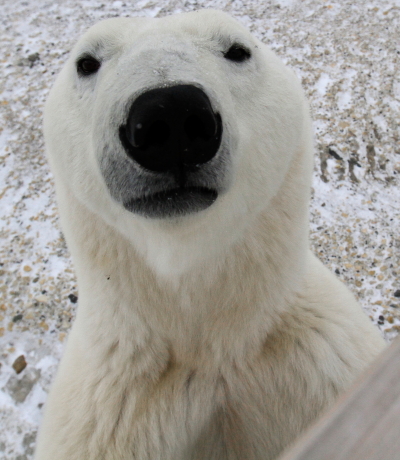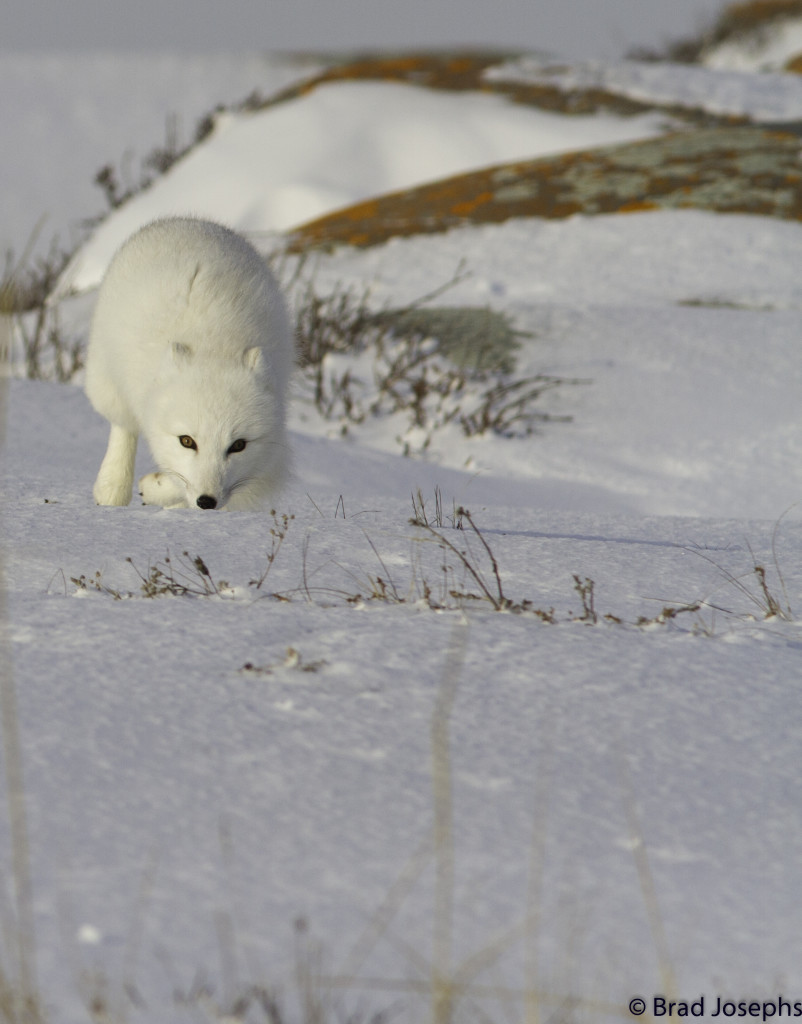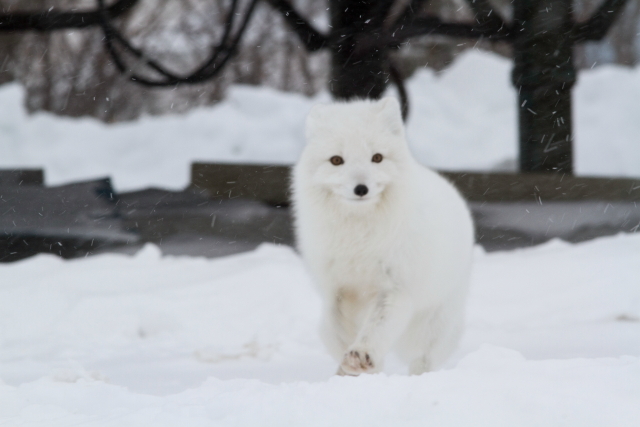by Steve Selden | Jan 9, 2015 | Churchill News
Eskimo kissing as we know it in western culture never really happens the way it’s depicted in movies or media. The myth of Inuit or Eskimo’s kissing by touching nose to nose as a romantic gesture is only myth. The gesture is based loosely on a traditional Inuit greeting called a kunik. The Hudson Bay coast north of Churchill is predominately Inuit.

A kunik is a way of expressing affection, usually between loved ones and family members, involving pressing the nose and upper lip against the loved ones’ skin (often the forehead or cheeks ) and breathing in, causing the loved one’s skin or hair to be suctioned close to the nose and upper lip.
This practice morphed into the myth that Inuit “kissed” this way to prevent their mouths from freezing together. Nanook of the North, the infamous 1922 documentary of Inuit life in the northern regions may have spurred the myth by depicting such behavior in the film. The gesture, in actuality, is a non-erotic greeting between Inuit that often have only noses and eyes exposed due to the severity of the cold weather in the northern region.

Would you give a polar bear an Eskimo kiss? Brad Josephs photo.
Yes Inuits kiss on the lips just like most other people in the world. With all the flu viruses circulating around the west, especially in wintertime, maybe we all should adopt the kunik during those contagious times.
Hope you enjoy this northern culture video from Blick Van Glory. Eskimo Love Song is their second music video that was produced in 2008.
by Steve Selden | Jan 8, 2015 | Videos
When you visualize snorkeling you usually think about the Caribbean and warm water lapping your tanning skin. Well, Churchill snorkeling is slightly different….about 30 degrees cooler in water temperature to be frank.
However, Sea North Tours in Churchill has all the insulated dry suits and gear to facilitate jumping into the Churchill River to mingle with the “canaries of the sea”, as beluga whales are known. This video has some amazing sound captured from the hydrophone equipment on the accompanying zodiac.
I can tell you first-hand this surely is an incredible experience you will remember forever!
by Steve Selden | Jan 7, 2015 | Churchill News
If you have been to Churchill you have more than likely seen the infamous Ithaca shipwreck just off the coast heading toward the airport or polar rover launch-site. The ship rests on the sea-bed 12 miles east of Churchill in Bird Cove.
Built in Three – Rivers, Quebec the Ithaca is eighty meters in length. Operated by the Clarke Steamship Company to deliver nickel concentrate from the works at Rankin Inlet, she sailed from Churchill on 10 September 1960 to collect her cargo, carrying supplies for the settlement. The ship’s rudder fractured in an 80 mph gale force wind and when anchors failed to hold she ran aground on September 14, 1960. The vessel came to rest on the rocky shoals, where it sits today, and all 37 men aboard were rescued.

MV Ithaca (September 2012)
Source: Heidi den Haan
Low tide often allows locals and travelers to walk out to the wreck and gain a close-up vantage point of the rusty behemoth. You will need to keep an eye on the tide chart however as you might end booked in a “rustic” cabin heading nowhere fast. It has happened.
There’s a bit more history of the Ithaca but this is the main crux of the wreck. It stands in the Hudson Bay as a monument to all those seamen that have traveled the waters of the north.
by Steve Selden | Jan 6, 2015 | Churchill News
Birds love Churchill in the summer months when the Arctic food chain grows exponentially to take advantage of the short warm season. The tidal pools and coastlines are teeming with plankton, krill, capelin and many other food sources unmatched by any other region in the world. The pure number of birds migrating to Churchill in the spring certainly is a testimony to the bounty of the Arctic.

Hudsonian Godwit in flight. A. J. Hand photo.
Nearly 250 bird species appear in Churchill over the course of the year. Most of those are “summer” migratory species while some reside in the region year-round. Personally, I feel the ones that come and go tend to be more intriguing.
Today’s focus is on the Hudsonian Godwit, a large shorebird with a long, upturned bill. This bird breeds in the Arctic and winters in southern South America. Because of its remote breeding and wintering grounds the godwit is one of the more obscure American shorebirds.

Fall migration routes for Hudsonian godwits Kendall and Sig. Significant staging areas were documented along Hudson/James Bay and within Colombia, Venezuela, Brazil, and Bolivia. Map by CCB.
Nesting on the mixed tundra and wetlands of northern Canada and Alaska, the godwit travels across the great plains of the United States in the spring then returns south along the Atlantic coast to South America in the winter. Reported nonstop flights of several thousand miles between these sites are not uncommon. At times, in the fall, “touch-downs” on the Atlantic coast are necessitated by northeasterly winds.
The long upward bill of the godwit digs in muddy, rocky or sandy shorelines as well as marshes, mudflats and flooded tundra or fields. The length of the bill allows it to search deep in the earth to acquire insects or organisms unreachable by other foragers. The Hudsonian, however, is the smallest of the four godwit species. In my guiding days I would associate the upturned bill with “god”, (heaven generally thought of as above in the sky) in order to help identify the bird from a distance or while mixed in with other shorebirds. Whimbrels have similar long bills, though slightly curving downwards, and dowitchers have more straight, dagger-like bills. All three are found on the shores of Churchill in the spring and summertime. Due to their similar feather markings and size, the bills are quick and easy identifying symbols.

Hudsonian Godwit in breeding plumage. Seth Kellog photo.
The Allen Bird Club website can be found at massbird.org/allen
Seth Kellogg can be reached at skhawk@comcast.net
Once thought of as one of North America’s rarest birds it now is know to be more prolific. Vulnerability for the species remains quite high as the population is confined to only a few locales geographically.
When found in groups, godwits are generally collectively known as an “omniscience”, “pantheon” or “prayer”. A “prayer of godwits” fits quite nicely with my bill reference for identification. These birds truly are incredible in all facets of their lives.
If you have the urge to track the summer life cycle of the Hudsonian Godwit, come to Churchill with Natural Habitat Adventures! Visit nathab.com for details.
by Steve Selden | Jan 5, 2015 | Churchill Photography
This week’s Churchill photos are of Arctic fox. These beautiful Arctic animals are constantly scavenging for food either on the tundra or out on the sea ice, following the polar bears and feeding opportunistically on their seal-kill leftovers. Often they battle for territory with the red fox year over year. That seems a little harsh considering the “Arctic” fox really is at home.

Arctic fox sniffing the tundra for prey. Brad Josephs photo.

Arctic fox moves deliberately across the tundra keeping a watchful eye on a rover. Brad Josephs photo.


Red fox along the coast in Churchill,MB. Brad Josephs photo.











